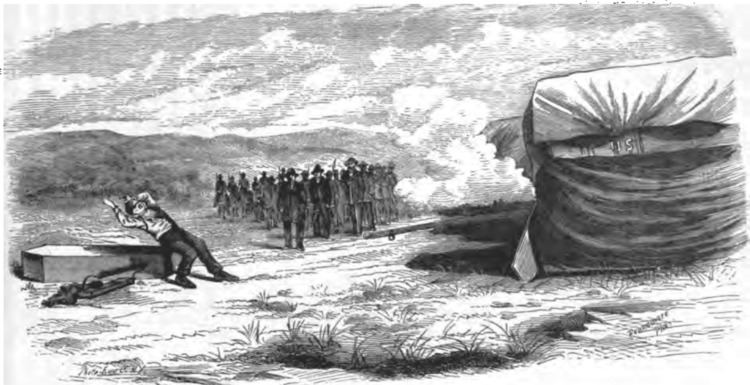 | ||
Capital punishment is legal in the U.S. state of Utah. Aggravated murder is the only crime subject to the penalty of death under Utah law. Lethal injection is the state's execution method of choice; however, the firing squad is also available in certain circumstances. As of May 8, 2011, nine people are under a sentence of death in the state. Since 1850, 51 individuals have been executed in Utah. It was the first state to resume executions after the 1967-1976 national moratorium on capital punishment.
Contents
History and current practices
The spring 1850 garroting of Patsowits, a Ute, was the first recorded execution in the provisional State of Deseret. Utah Territory was established in September 1850, and it permitted condemned prisoners to choose between hanging and firing squad. In 1851 beheading was introduced as a third execution option. No prisoner chose this method and the option was eliminated in 1888. In 1955, Utah state lawmakers voted to introduce the electric chair; however, the state never used electrocution due to failure to provide appropriation. Forty-four executions occurred in the State of Utah and Utah Territory before the national moratorium in 1967; six were by hanging and 38 were by firing squad. The last pre-moratorium execution in Utah took place on March 30, 1960.
In 1967 when the moratorium went into effect, Utah was the only remaining state to allow death row inmates to choose between firing squad and hanging. Utah attempted to reintroduce death penalty statutes during the moratorium but they were struck down by the 1972 United States Supreme Court decision in the case Furman v. Georgia. The state formally reinstated capital punishment on January 7, 1973 and the new death penalty statutes were approved by the United States Supreme Court with the reinstatement of capital punishment in 1976. The reinstatement allowed Utah to move forward with the death sentences of Dale Selby Pierre and William Andrews for crimes committed in 1974 prior to the reinstatement of capital punishment. (They were later executed in 1987 and 1992, respectively.) On January 17, 1977, Utah became the first state to execute a prisoner after the moratorium ended: Gary Gilmore was executed by a firing squad, having selected that method over hanging. In 1958 twenty-one-year-old Barton Kay Kirkham became the last prisoner to be hanged by the state of Utah. Lethal injection was introduced in 1980 and in February of that year the Utah State Legislature replaced the option of hanging with the option of lethal injection.
The first bill proposing to eliminate the firing squad option was introduced in the Utah House of Representatives in January 1996. In 2004, the legislature passed HB180, which removed the right of the condemned to choose the method of execution and left lethal injection as the only remaining option in the state. The abolition of the firing squad was not retroactive; three inmates on death row at Utah State Prison who chose this method of execution before the end of February 2004 will be executed by firing squad under a grandfather clause. Utah's most recent execution, that of 49-year-old Ronnie Lee Gardner on June 18, 2010, was the state's third execution by firing squad since the capital punishment moratorium was lifted, and the country's first sanctioned shooting in 14 years. Legislation signed by Gov. Gary Herbert in March 2015 restores the firing squad as a legal method of execution, requiring its use if the state is unable to obtain the necessary lethal injection drugs within 30 days of a scheduled execution.
Utah is the only state besides Nevada to have ever used the firing squad, although executions of this type are authorized in Oklahoma for prisoners who successfully challenge the constitutionality of lethal injection and electrocution.
Executions in Utah are currently performed at the Utah State Prison in Draper, Utah. Because the ethics standards of the American Medical Association forbid physician involvement in executions, other healthcare professionals including paramedics and nurses perform executions in Utah. Paramedics and nurses, however, are also forbidden from participation in executions by their own professional organizations' ethics codes. The prison protects the anonymity of professionals involved in executions, making it impossible for professional organizations to impose sanctions.
Conviction and sentencing process
Convicts who were under 18 at the time of commission of the crime and convicts who are mentally retarded are protected from the death penalty in Utah, as they are in all states, under federal law. Defendants in capital cases in the state of Utah may choose either a jury trial or a bench trial in which the judge alone decides the verdict and sentence. John Albert Taylor is the only Utah defendant to waive his jury right. He was convicted and sentenced to death in 1989 by 2nd District Court Judge David Roth in Weber County. Clemency rests with the State of Utah Board of Pardons and Parole, of which the Governor of Utah is a member, making Utah one of a handful of states where the Governor does not have the sole power to grant clemency. As of 2008 no commutation of the death sentence has been given in Utah.
Definition of aggravated murder
Under Utah law, aggravated murder is the only crime subject to the penalty of death. It is defined as follows:
